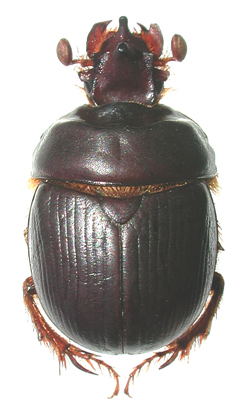| .. |
Scarabaeoidea of Southern South America Links
|
.
Keys |
|
| |
| .. |
Scarab Guide Links
(goes to the University of Nebraska
web site) |
.
Classification |
|
|
| |
|
| . |
.
Bolborhinum shajovskoyi (Martínez, 1952) |
| |

|
|
male |
female |
Bolborhinum shajovskoyi. |
| |
|
Bolborhinum shajovskoyi, male. |
| |
|
Bolborhinum shajovskoyi, female. |
| |
|
Distribution of Bolborhinum shajovskoyi in southern South America. |
| |
|
...... |
Original combination: Bolboceras shajovskoyi Martínez, 1952: 318.
Type locality: “Argentina, territorio nacional de Neuquén, San Martín de los Andes.”
Type series: holotype male at MACN labeled a) S.M.Andes / P. Nac. Lanín / L. Swaryczewski (typeset), b) “HOLOTYPUS” (typeset, faded red label), c) “Bolboceras / shajovskoyi sp. n. m#” (handwritten by Martínez, red label), d) “Southern Neotropical Scarabs / database # JM2000595 / Bolborhinum shajovskoyi / (Martínez, 1951) m# / DET: J. MONDACA E. 2007” (typeset). Allotype female at MACN labeled a) “Enero 1950 / S.M. Andes / I.Schajovskoi” (typeset), b) “ALLOTYPUS” (typeset, faded red label), c) “Bolboceras / shajovskoyi sp. n. f#” (handwritten by Martínez, red label), d) “Southern Neotropical Scarabs / database # JM2000596 / Bolborhinum shajovskoyi / (Martínez, 1951) / DET: J. MONDACA E. 2007” (typeset). Four male and two female paratypes at HAHC. |
| |
...... |
| |
Specimens examined: 25 specimens were examined from FMNH, HAHC, IADIZA, JEBC, JMEC, LACM, MACN. |
| |
|
|
Diagnosis. Length 17.0-19.0 mm. Color dark brown in males and reddish-brown in females. This species is distinguished from other Bolborhinum by the shape and placement of the male cephalic horns. Head dorsally rugulose, with two clypeal horns and two lateral, triangular processes; first clypeal horn directed anteriorly, slightly curved, situated at midline of clypeal apex, less developed that the second; second horn located immediately behind the first, robust, slightly inclinated anteriorly, with apex obtuse, widened distally. Frontoclypeal surface laterally with two strongly elevated cariniform processes that converge distally; vertex depressed, impunctate. Pronotum with deep, wide anterior excavation; pronotal declivity straight, perfectly parallel at postero-lateral margin of the pronotum (lateral view); postero-superior ridge transverse, subrectum, slightly sinuate medially.
Females similar to males, except in the trapezoidal shape of the head and total absence of horns; dorsal surface with an elevated tubercle and two lateral processes on the frontoclypeal region. Pronotum with weak depression located immediately behind of the anterior margin; dorsal surface densely covered with small punctures, laterally densely rugopunctate. |
| |
|
|
Distribution (Fig. 60): ARGENTINA (23). Mendoza (1): Laguna Diamantes (1). Neuquén (20): Auca Pan (2), Collón Curá (1), Junín de los Andes (1), Las Taguas (2), Parque Nacional Lanín; San Martín de los Andes (7), Tipilinka (1), Río Alumine (1), San Martín de Los Andes (5). Río Negro (2): Bariloche (1), El Bolsón (1). CHILE (2). IX Región de La Araucanía (2): Liucura, Pino Hachado (2). |
| |
|
|
Temporal data. January (10), February (1), November (7), December (5). |
| . |
|
| |
Remarks: The specimen of this species collected in Mendoza represents a northern range extension of approximately 400 km. More collecting is obviously needed in the montane regions of Mendoza and Neuquén to fill in the gaps and get a complete picture of the distribution of this species. |
| |
|
| |
Excerpt from:
Mondaca, J. and A.B.T. Smith. (2008) A revision of the southern South American genus Bolborhinum Boucomont (Coleoptera: Geotrupidae: Bolboceratinae). Zootaxa, 1794, 1-48. |
| |
|

